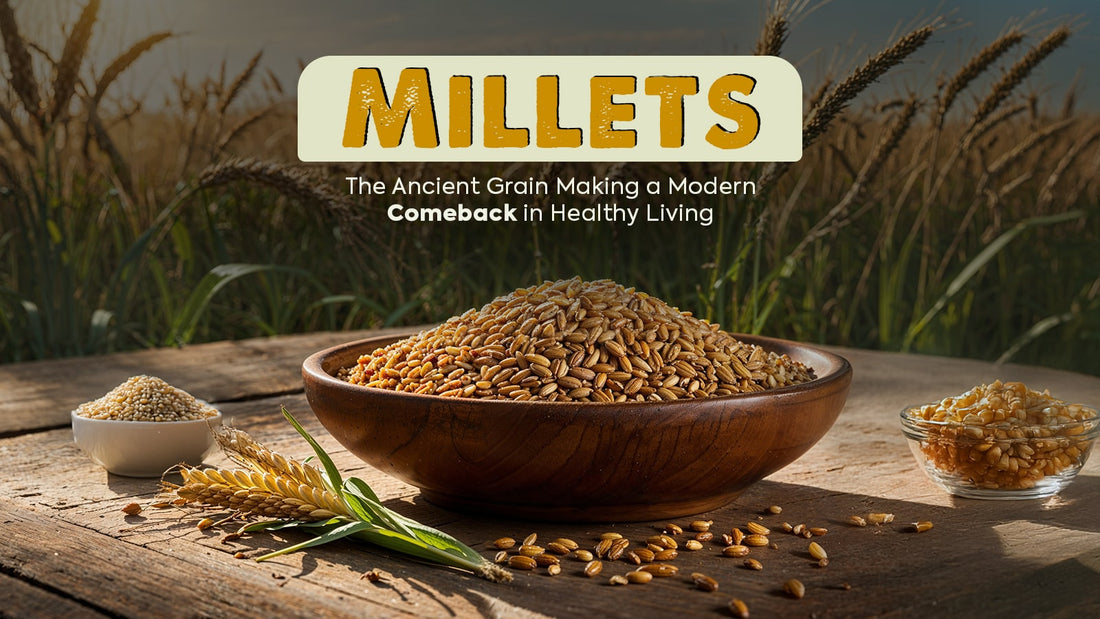
Millets: The Ancient Grain Making a Modern Comeback in Healthy Living
Share
📑 Table of Topics
Introduction | What Are Millets? | Types of Millets Commonly Used in India | Top Health Benefits of Millets | How to Include Millets in Your Daily Diet | Millet for Weight Loss and Fitness | Millet vs. Rice and Wheat: Which Is Healthier? | Precautions and Who Should Eat Millets | ConclusionIntroduction
There is a new buzzword in the health and wellness world — millets. But this isn’t really new. Millets have been a part of Indian diets for thousands of years. Our grandparents enjoyed them daily in the form of rotis, porridge, or fermented dishes. Unfortunately, with the rise of polished rice and refined wheat, millets lost their place in modern kitchens.
As people return to more natural and wholesome eating habits, millets are once again gaining popularity — not just in India, but around the world. They’re being hailed as “climate-smart grains” because they’re good for both your body and the planet.
What Are Millets?
Millets are small-seeded grains that belong to the grass family. They’re hardy crops that grow in dry and semi-arid regions, requiring very little water or fertilizers.
Unlike polished rice or refined wheat, millets are rich in fiber, protein, vitamins, and minerals. They come in several varieties, each with unique health benefits.
In India, millets are often divided into major millets and minor millets :
- Major millets include pearl millet (bajra), finger millet (ragi), and sorghum (jowar).
- Minor millets include foxtail millet, barnyard millet, little millet, and kodo millet.
The Government of India even declared 2023 as the International Year of Millets, recognizing their immense health and environmental importance.
Types of Millets Commonly Used in India
Here’s a quick look at some popular types of millets and their uses:
1. Jowar (Sorghum): Great for rotis, rich in fiber, and helps regulate blood sugar.
2. Bajra (Pearl Millet): Known for its warming properties and high iron content.
3. Ragi (Finger Millet):Packed with calcium, ideal for bone health and growing children.
4. Foxtail Millet: Low glycemic index, perfect for diabetics.
5. Little Millet: Light on the stomach and excellent for detoxification.
6. Barnyard Millet: A fasting favorite, helps manage cholesterol.
7. Kodo Millet: Rich in antioxidants and helps in managing weight..
Each millet has a distinct taste and texture, making them versatile and suitable for a range of recipes — from traditional Indian dishes to modern bowls and salads.
Top Health Benefits of Millets
Improves Digestion
Millets are rich in dietary fiber, which promotes better digestion and helps prevent constipation. They also support a healthy gut microbiome.
Supports Heart Health
Rich in magnesium and potassium, millets help lower bad cholesterol levels and improve blood circulation, reducing the risk of heart disease.
Boosts Energy and Stamina
Millets provide slow-releasing complex carbohydrates, giving you sustained energy throughout the day — perfect for active individuals and athletes.
Helps in Weight Management
Being low in calories and high in fiber, millets keep you full longer, reducing unnecessary snacking and aiding in healthy weight management.
Controls Blood Sugar Levels
The low glycemic index of millets makes them ideal for people with diabetes. They prevent sudden spikes in blood sugar after meals.
Enhances Brain Function
Millets are rich in iron and B vitamins, which improve oxygen flow and support better concentration and memory.
Good for Skin and Hair
The amino acids and antioxidants present in millets help maintain skin elasticity and promote stronger hair growth naturally.
How to Include Millets in Your Daily Diet
Adding millets to your routine doesn’t mean you have to give up your favorite foods. Small changes can make a big difference:
- Breakfast: Try ragi dosa, millet upma, or foxtail millet porridge
- Lunch: Replace white rice with cooked jowar or bajra.
- Dinner: Make millet khichdi, pulao, or chapati.
- Snacks: Millet laddus, cookies, or energy bars are great healthy alternatives.
- Drinks:Ragi malt or bajra smoothie can be refreshing and nutritious.
Millet for Weight Loss and Fitness
Fitness enthusiasts love millets because they provide sustained energy without the crash that comes from processed carbs. The high fiber content aids in digestion and fat metabolism, making millets a must-have for anyone focused on fitness or weight loss.
Millets like ragi and foxtail millet are especially beneficial because they curb hunger pangs while keeping the body fueled for workouts. Pairing millets with proteins like lentils or yogurt can make meals more balanced and satisfying.
Millet vs. Rice and Wheat: Which Is Healthier?
While rice and wheat have long been dietary staples, millets are far superior in nutrition. Here’s why:
- More Fiber: Millets aid digestion and control blood sugar better than polished rice
- Higher Protein: Helps in muscle repair and weight management.
- Low GI (Glycemic Index): Prevents sugar spikes
- More Micronutrients: Rich in iron, magnesium, and calcium. Unlike refined grains, millets retain their natural bran and nutrients, making them more wholesome and filling.
Precautions and Who Should Eat Millets
While millets are safe and beneficial for most people, moderation is key.
- People with thyroid issues should limit goitrogenic millets like pearl millet.
- Always soak or sprout millets before cooking to improve nutrient absorption.
- Start slowly to let your digestive system adapt.
Pregnant women, diabetics, and elderly individuals can safely enjoy millets when incorporated as part of a balanced diet.
Conclusion
Millets are not just food — they’re nature’s way of nourishing and healing us. From boosting digestion and improving heart health to aiding in weight loss and providing lasting energy, millets truly are the complete wellness grain.
If you’re ready to take your health to the next level, start by introducing millets into your meals. Explore natural health and wellness products at sehatokart to complement your millet-based diet and live a healthier, balanced life.
